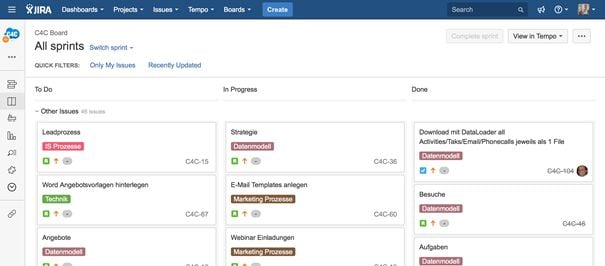It was with great enthusiasm that we embarked on our “Replacing Salesforce.com (SFDC) with SAP Hybris Cloud for Customer” project. I certainly would have never imagined that I'd be heading a project for my own employer.
We Are Staying in the Cloud
The cloud is a must for anyone looking to deploy a state-of-the-art customer relationship management system. Learn why and how SAP has managed to surpass the industry's golden child Salesforce, reading this article in german here. We had already embraced the cloud while still working with our previous Salesforce solution, as we pointed out in part 1 of our blog series. Going back to on-premises? UNTHINKABLE. Since then, we have gradually moved other business areas into the cloud as well. Since we already knew that we were doing, the deployment of our C4C system was a very straightforward affair.
Agile Project Management With Jira
Starting a project means defining its scope. I rather dislike just dictating it. I'm more for working as a team to come up with it in a joint effort. This is how I make sure that everyone who contributes to the project knows and understands exactly what we are doing and why we are doing it. Everyone on the team needs to have a basic grasp of how the project is organized, what it's major milestones are, and how we are going to approach it so we can all join forces. At IBsolution, we have been relying on Atlassian Jira as our steering tool of choice for several years now. It also ensures a very agile approach to our C4C project. Once we had our C4C system deployed in the cloud, we benchmarked and set weekly and monthly targets and created our first tickets.

This will save us a lot of time and trouble, most of all later on during the testing states. It guarantees that everything we do is properly documented, allowing us to focus on our to-do lists.
Mapping & Process Design
Copy & paste, extract – upload. If only it were that easy ... Even as a consultant, you don't always get what you want and so it's mapping first: This means we will look closely into the data and data models of both solutions and then compare and adapt them to ensure their smooth upload to C4C. C4C uses keys for most data, for example to harmonize academic titles. Salesforce, on the other hand, relies on manual input, with the result that you will frequently find "Doctor xyz" stored as "Dr." and less often so as "MD". This requires a detailed analysis of what format the data is actually in: In what form and in what order does C4C need the data to be in order to match it correctly?
Why do we do it? Let's look at an easy example: Imagine we would mix up "first name" and "last name" and then mismatch the data. That would make "Mr. Jonathan Myers" "Mr. Myers Jonathan". What do you think how he would react if in our next email we would address him as "Mr. Jonathan"? Very embarrassing. And this is still harmless. I can't even imagine the chaos that would ensue if we were to confuse bank codes and bank account numbers of our accounts payable and accounts receivable.
This only gets us half the way though. It is at least equally important to find out how workflows and processes are mapped and handled. We were sometimes forced to completely rethink our approach because C4C, other than Salesforce, allows us to seamlessly integrate our workflows. These differences in the data models sometimes leave us IT people no choice but to get pretty creative to make the transition work. Throwing it all out and starting from scratch is not an option. This is data that has been gathered over many years and it is simply too valuable.
Find out more about data mapping and what to look out for in this article.
Preparing the Data Migration
A successful data migration is intrinsically tied to the quality of the data. The higher the quality of the data in your legacy system, the higher the probability of successfully moving it to the new system. Unfortunately, we had to improve considerably more than originally expected. This, however, is also a crucial stage in the project and usually the right time to ask yourself: "Do we really need all this data and if we do, for what and for whom?". The perfect opportunity, really, to get rid of any "junk data". But we will come back to this in our next article.
In order to seamlessly integrate all data, we will, for example, define customer-specific marketing attributes in C4C and use them to structure our data. Salesforce does so by means of custom fields, making it easy to lose track of your work. The marketing and sales departments at IBsolution frequently rely on dynamic customer groups in their work. For them, marketing attributes are fundamental to ensure that they target the right audience at the right time. This is where they store information on the systems their customers use, lead scores, and much more. We will take a closer look at this in the next part of our blog series – so be sure to check back for more.
So far, so good. The most important thing for now: We are on time!
![IBacademy_Logo_blau[496] IBacademy_Logo_blau[496]](https://www.ibsolution.com/hs-fs/hubfs/IBacademy_Logo_blau%5B496%5D.jpg?width=200&name=IBacademy_Logo_blau%5B496%5D.jpg)



